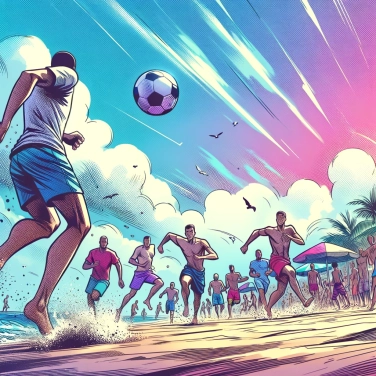Beach soccer is played barefoot on the sand to provide better grip, allowing players to have better control of the ball on a surface that can be slippery.

Beach soccer started in Brazil in the 1940s, on the beaches of Rio de Janeiro. At first, it was simply players competing for fun on the warm sand before becoming a full-fledged sport. Gradually, this type of sand football developed its own rules, quite different from traditional football. It is played on a sandy field much smaller than a standard pitch, with two teams of five players. Matches are very dynamic, fast, and spectacular, featuring a lot of acrobatics and aerial strikes. The uneven surface of the sand makes the ball unpredictable, pushing players to play mainly in the air and to be technically creative.
Playing barefoot allows for better grip on the sand and enables direct feel for the ground, which greatly aids in ball control. On an unstable surface like sand, being barefoot provides much better stability than shoes or socks. It also reduces the risk of ankle injuries, as the feet don’t have to contend with a rigid sole that doesn’t conform to the shape of the ground. Furthermore, without shoes, aerial and acrobatic play becomes easier to execute: attempting a backflip with cleats is a guaranteed accident! Thus, playing barefoot is as much about safety as it is about agility and comfort on a specific surface like sand.
Playing on sand changes everything. This soft and unstable surface requires players to exert a different, more intense physical effort, especially for the legs and ankles. As a result, each movement costs more energy, but also offers more freedom in acrobatic moves like volleys or bicycle kicks. The sand absorbs impacts, allowing for spectacular play with a lower risk of serious injury when you fall. The uneven surface also alters the trajectory and bounce of the ball, making the game unpredictable and fun, while demanding a particular technique to maintain control. The constant instability fosters players' creativity, forcing quick and spontaneous movements while constantly testing their balance and agility.
Playing barefoot beach soccer on sand reduces the risk of serious injuries compared to a traditional hard surface. But be careful, sand also has its challenges, such as the risks of cuts from broken shells or buried debris. Players must also monitor the surface temperature: under intense sun, the sand can become so hot that it causes burns to the feet. Another common risk is ankle sprains, as the unstable surface constantly requires adjustments to one's footing. Finally, beware of the delicate skin on the soles of the feet, which, subjected to friction and humidity, can suffer from blisters or irritations.
Playing barefoot on the sand directly influences several aspects of the official beach soccer regulations. Physical contact is closely monitored, as a sole that crushes an unprotected foot can quickly lead to injury. Logically, dangerous actions incur swift penalties: a dangerous play will be punished more severely than in traditional football. Additionally, referees must constantly monitor the condition of the sand, which can hide sharp or hard objects. A small peculiarity: the ball is never fully inflated to remain comfortable and maneuverable when barefoot, thus altering the official rules regarding the pressure and type of ball to be used. Finally, the regulations regularly impose surface checks to ensure player safety, which is not specifically done systematically in other variants of football.
Unlike the cleats used in traditional football, playing barefoot on sand enhances players' ability to feel the ball, thus promoting a more technical and spectacular game.
The sand used in official beach soccer competitions must meet specific grain size criteria and be free of stones or other hazardous elements to ensure the safety of barefoot players.
Beach soccer is played with short matches: only three periods of 12 minutes each, in order to reduce exhaustion caused by the sand, a surface that is particularly physically demanding.
Beach soccer players burn on average up to twice as many calories per match as players on grass, as the sand increases the difficulty of movement and jumping.
Playing barefoot carries some risks, including cuts from objects buried in the sand, sprains caused by quick movements or uneven surfaces, and burns from very hot sand. However, competition organizers generally ensure that the playing field is clean and safe before official matches.
Yes, playing barefoot on the sand significantly alters the playing style. This practice encourages a more precise technical approach, quick movements, better proprioception, and challenges players to improve their balance and agility.
No, the official regulations also allow the use of artificial sand, provided it meets certain particle size and safety standards set by international bodies. This ensures optimal performance and increased safety for the players.
Professional players pay great attention to the care of their feet after matches or tournaments. They frequently use restorative, moisturizing, and anti-inflammatory creams, take relaxing foot baths, and closely monitor any signs of injury to prevent potential complications.
Although traditional beach soccer is played barefoot to facilitate mobility and movement on the sand, some amateur players use special shoes like neoprene booties to protect their feet. However, these items are generally not permitted in official competitions.

0% of respondents passed this quiz completely!
Question 1/5